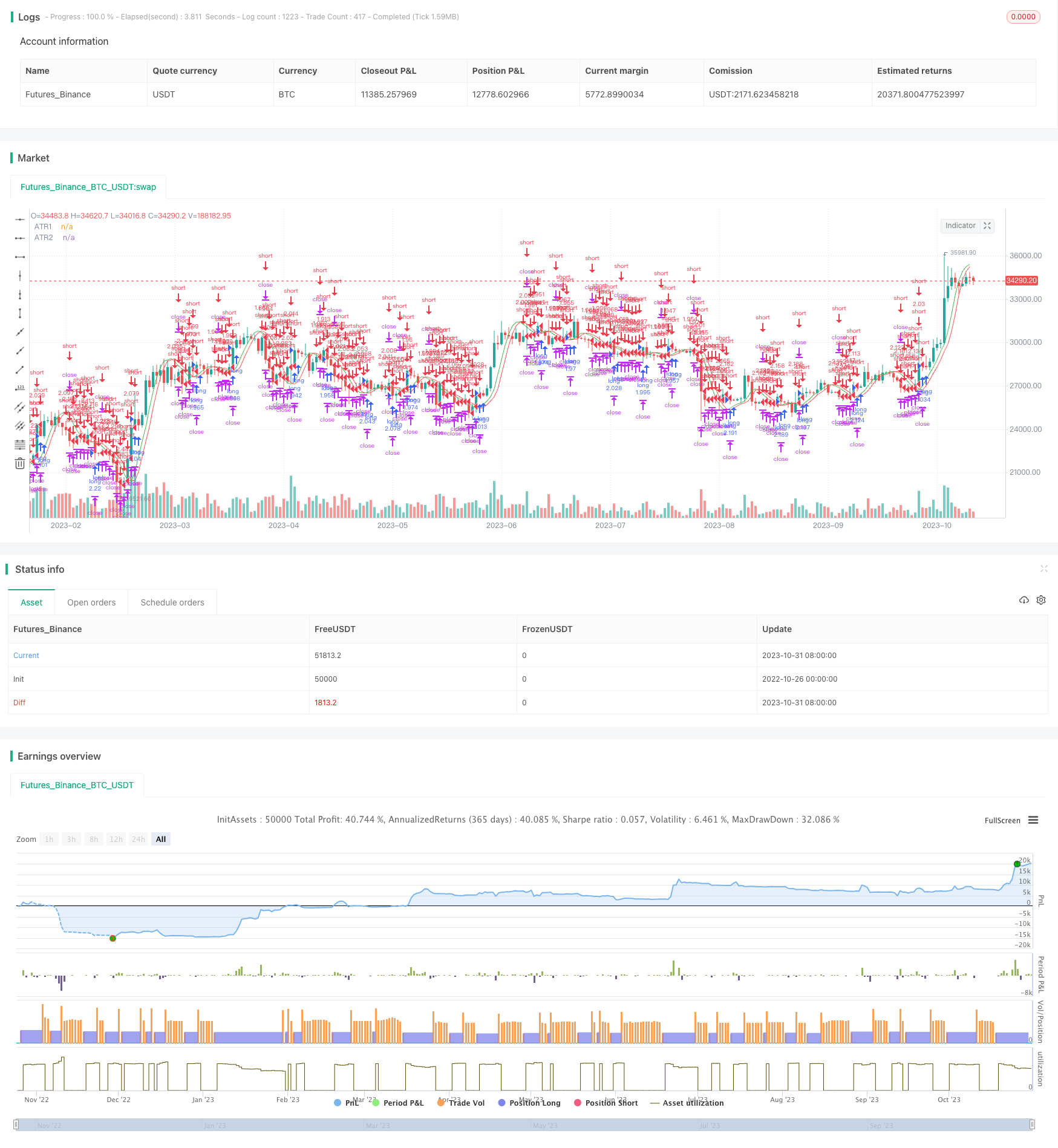
概述
本策略融合自适应ATR均线指标和趋势跟踪,用于发现市场中的趋势并进行趋势交易。该策略运用Hull移动平均平滑ATR,形成平滑的ATR均线,再根据价格与ATR均线的关系发出交易信号。ATR均线能够有效过滤市场Noise,识别出较大的趋势。本策略还设置了固定止损止盈点,控制每单的风险收益比。总体来说,该策略通过自适应ATR均线指标追踪趋势,并采用严格的风险管理规则,旨在实现稳定的盈利增长。
策略原理
本策略的核心指标是ATR均线。ATR指标是Measuring Volatility的一个重要工具,它能够测量市场的波动性和股价的实际变动幅度。ATR均线则是对ATR指标进行平滑处理,形成均线之后,再与价格进行比较,判断价格趋势。
具体来说,该策略首先计算出TR(True Range),即当日最高价与最低价之间的差价,并取前一日Close与当前最高最低价之间的最大差价。然后应用Hull移动平均方法对TR进行平滑,计算出自适应的ATR均线。ATR均线能够有效过滤市场中高频的Noise,只捕捉到较大的价格波动。
在计算出ATR均线后,该策略将价格与ATR均线进行对比。当价格上穿ATR均线时,说明价格开始进入上升趋势,该策略则进行Long开仓;当价格下穿ATR均线时,说明价格开始进入下跌趋势,该策略则进行Short开仓。
此外,该策略还设置了固定的止损止盈范围。每次开仓后,设定固定的止损点和止盈点,当价格触及止损点时止损出场,触及止盈点时止盈出场。这能够限制每单的损失,同时锁定盈利。
综合来说,该策略融合自适应ATR均线指标和严格的风险管理措施,旨在抓住较大的价格趋势,同时控制每单损失,实现稳定的盈利增长。
优势分析
该策略主要具有以下优势:
使用自适应ATR均线指标,能够有效识别出价格中较大的趋势,过滤市场Noise,防止被套。
应用Hull移动平均方法计算ATR均线,使ATR均线更为平滑,避免被高频震荡误导。
设置固定止损止盈点,能够限制单笔损失,同时锁定盈利,保证每单交易的风险收益比。
采用趋势跟踪的交易方式,能够持续捕捉价格趋势,增强盈利的可能性。
策略逻辑简单清晰,容易理解,参数设置灵活,适合不同品种和市场环境。
可在任何品种中进行趋势跟踪,具有较强的适应性。
风险分析
该策略主要存在以下风险:
ATR均线发出错误信号的可能性。价格可能出现剧烈波动,导致ATR均线判断失误,产生错误信号。
止损点过小可能增加止损被触发的概率。需要确保止损点设置合理,给予价格足够的波动空间。
固定止盈目标可能过早止盈,未能持续捕捉趋势行情。可考虑根据ATR动态调整止盈点。
突发事件导致价格剧烈跳空,触发止损。此时需要暂停交易,防止巨额损失。
当趋势反转时,如果未及时平仓,可能会被反向套牢。需要及时判断趋势结束信号。
Parameters需要针对不同品种和市场环境进行优化,否则会影响策略表现。
优化方向
该策略可以从以下几个方面进行优化:
优化ATR均线的参数,包括ATR计算长度period和平滑参数。不同参数组合会对ATR均线产生影响。
优化止损止盈策略,可以考虑根据ATR动态调整止损止盈点,而不是固定设置。
增加趋势判断规则,结合其它指标判断趋势反转信号,避免被反转套牢。
根据不同品种和市场环境对参数进行测试和优化,找到最优参数。
增加对突发事件的判断,在大幅跳空时暂停交易,控制损失。
优化入场时机选择,可以考虑在回调时入场,而不是在冲高时入场,降低风险。
进行参数组合优化,测试不同ATR长度和平滑参数的组合,找到最佳匹配。
总结
本策略整体采用自适应ATR均线指标发现趋势,并以固定止损止盈的方式进行趋势跟踪交易。ATR均线能有效识别趋势,固定止损止盈控制风险收益比。该策略优点是逻辑简单清晰,容易理解;可根据参数调整适用于不同品种。但也存在ATR均线判断失误、止损点设置不当等风险。未来可通过优化ATR均线参数、止损止盈策略、增加趋势判断等方式进一步提升策略表现。
/*backtest
start: 2022-10-26 00:00:00
end: 2023-11-01 00:00:00
period: 1d
basePeriod: 1h
exchanges: [{"eid":"Futures_Binance","currency":"BTC_USDT"}]
*/
//@version=3
strategy("ATR(Hull)", overlay=true, default_qty_type=strategy.percent_of_equity, default_qty_value=100, calc_on_order_fills= false, calc_on_every_tick=true, pyramiding=0)
length = input(title="Length", defval=14, minval=1)
price = input(close)
SL = input(50, title="Stop loss")
TP = input(150, title="Take profit")
FromMonth = input(defval = 9, title = "From Month", minval = 1, maxval = 12)
FromDay = input(defval = 1, title = "From Day", minval = 1, maxval = 31)
FromYear = input(defval = 2018, title = "From Year", minval = 2017)
ToMonth = input(defval = 1, title = "To Month", minval = 1, maxval = 12)
ToDay = input(defval = 1, title = "To Day", minval = 1, maxval = 31)
ToYear = input(defval = 9999, title = "To Year", minval = 2017)
start = timestamp(FromYear, FromMonth, FromDay, 00, 00)
finish = timestamp(ToYear, ToMonth, ToDay, 23, 59)
window() => true
p=price[1]
func_hma(style, length)=>
return = wma((2*wma(p,length/2))-wma(p,length),round(sqrt(length)))
ATR=func_hma(tr(true), length)
plot(ATR[0], title="ATR1",color=green,transp=0)
plot(ATR[1], title="ATR2",color=red,transp=0)
if (ATR>ATR[1])
strategy.entry("long",strategy.long,comment="Long",when=window())
if (ATR<ATR[1])
strategy.entry("short",strategy.short,comment="Short",when=window())
//strategy.close_all(when=strategy.openprofit<-eqSL and window())
//strategy.close_all(when=strategy.openprofit>eqTP and window())
strategy.exit("exit", "long", profit = TP, loss = SL)
strategy.exit("exit", "short", profit = TP, loss = SL)